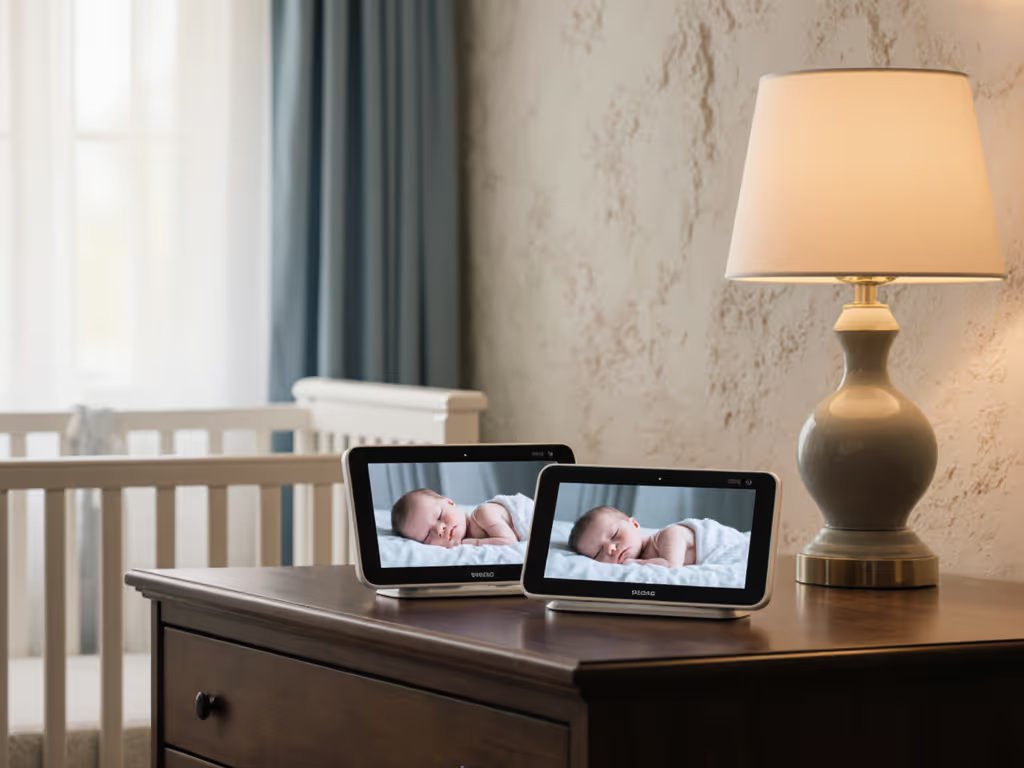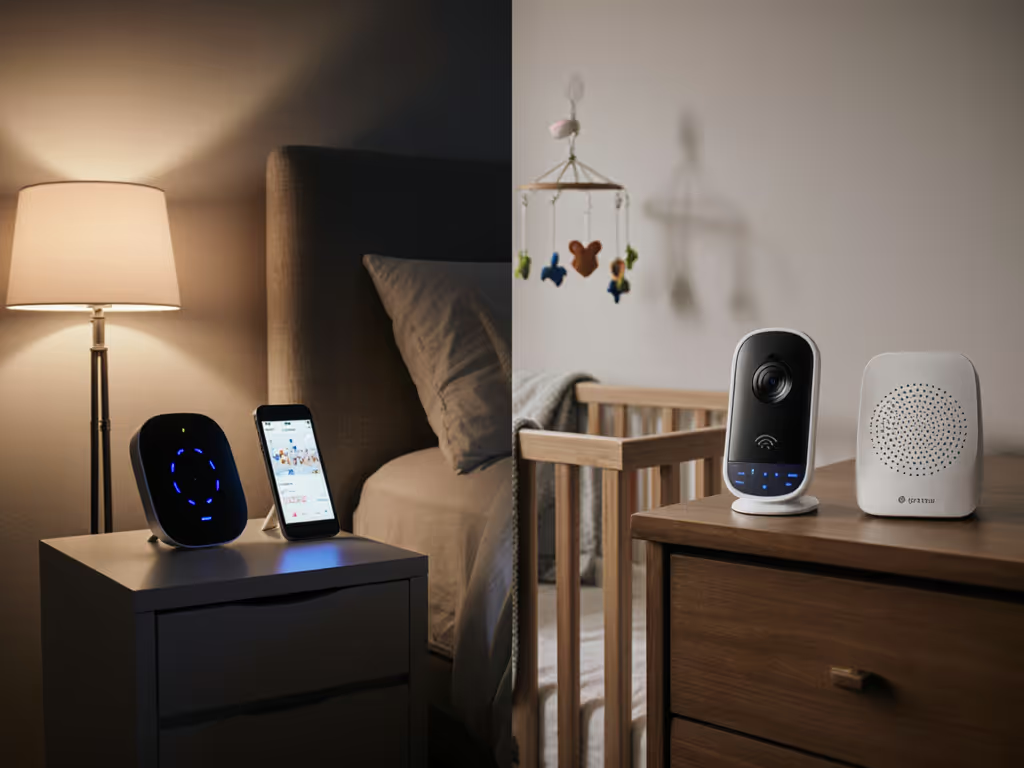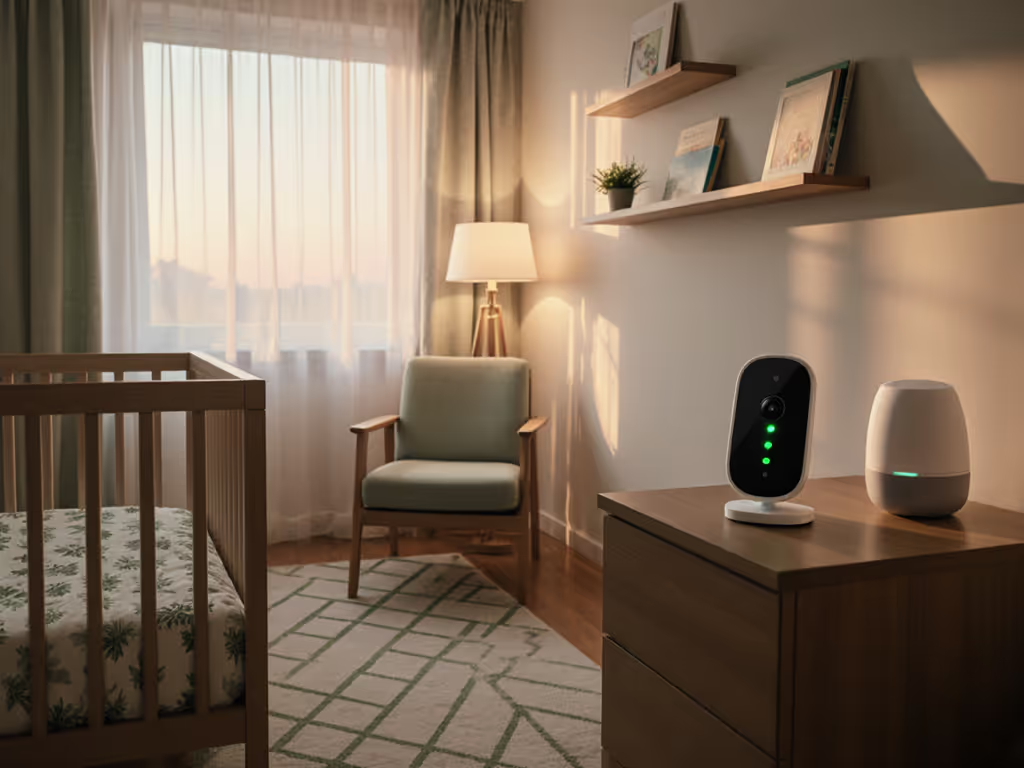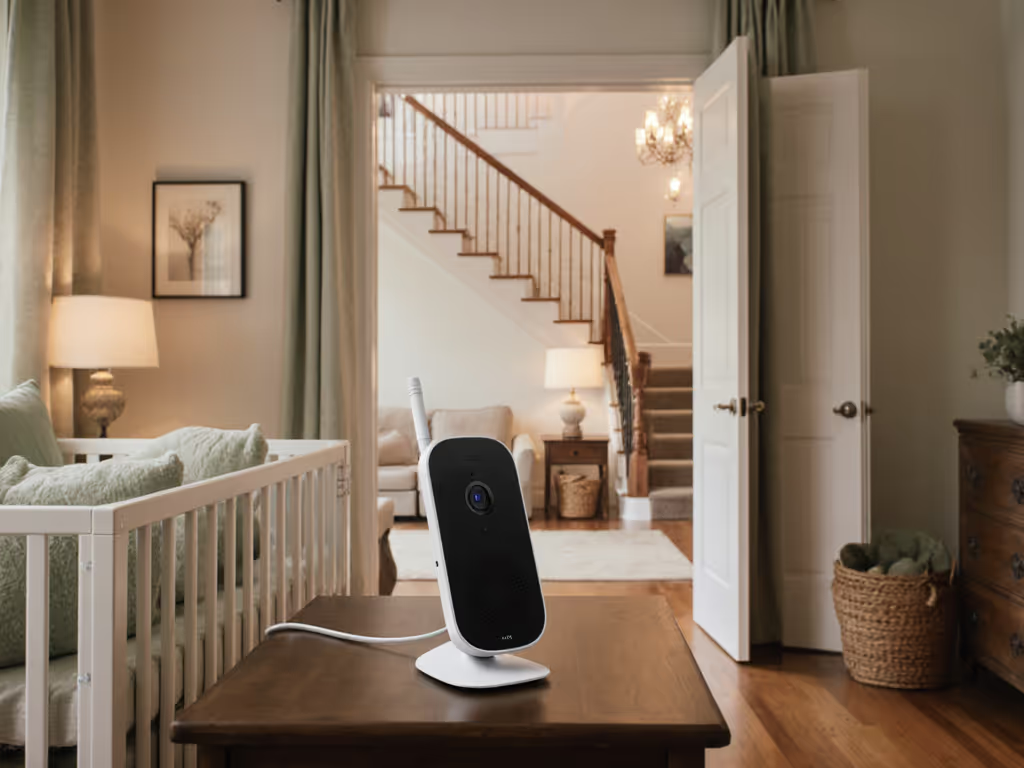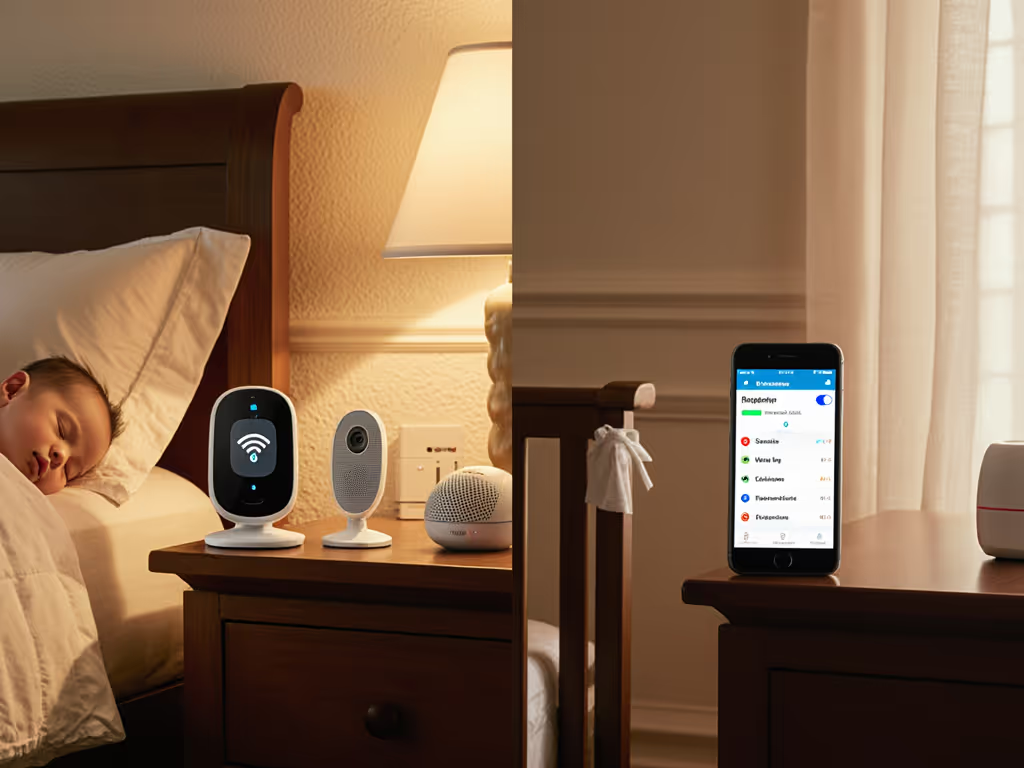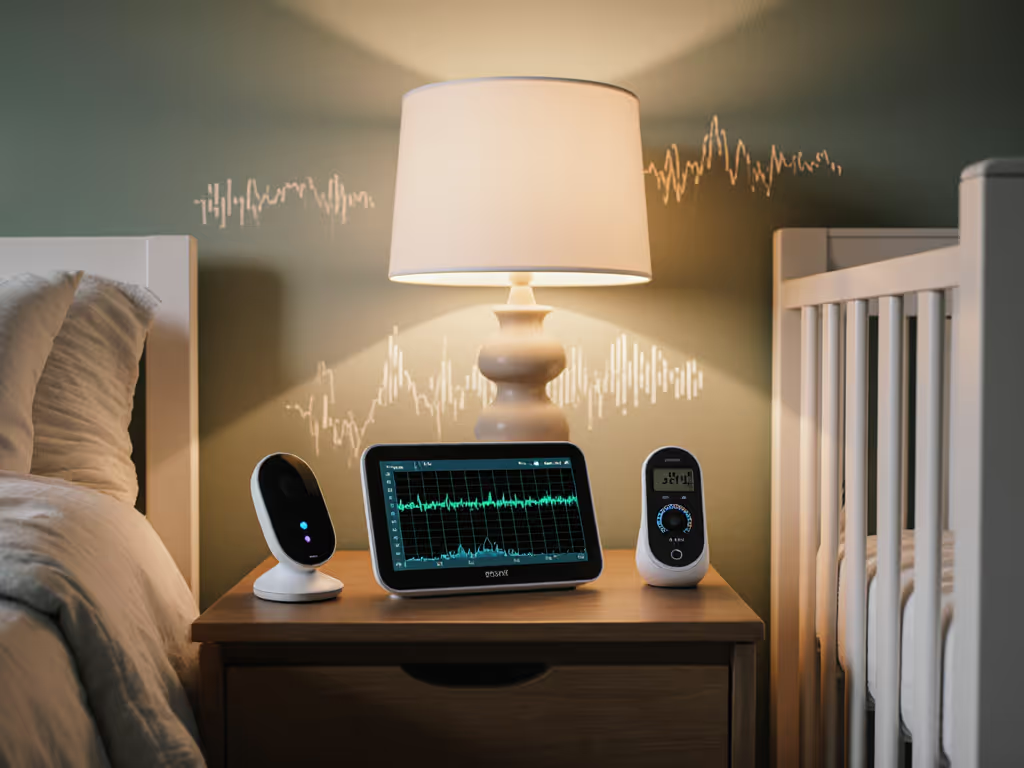Introduction
When parents ask me about wifi vs non wifi baby monitors, the real question is which is the best type of baby monitor for reliable, affordable sleep. I run the numbers on uptime per dollar. Reliable nights should not require premium budgets. Stability first, extras optional. If you take one line from me, make it this, Skip the sizzle, keep the signal.
I do plain talk, and I always start with outcomes. Your monitor either stays connected through the night, or it does not. Your dollars either buy calm, or they buy spinning wheels and app timeouts. My bias is simple, Pay once, sleep always, skip subscriptions and surprises.
Connection Reliability
Connection reliability decides whether you sleep.
Latency and responsiveness
- Non Wi-Fi handheld units that use FHSS or DECT usually show lower latency, around 150 to 250 ms video delay, with near real time audio. They are purpose built, the screen and radio are tuned to each other.
- Wi-Fi monitors ride your home network and your phone. On a solid dual band network, expect 250 to 600 ms delay locally. Add remote cloud relay and you can see 700 ms to 1.2 s. Audio talkback can lag a touch more.
Those numbers matter during a fussy stretch, when you tap talkback and expect to be heard right now. If you want the lowest and most consistent latency, non Wi-Fi still wins in most homes.
Dropouts and interference
I track uptime percentages during week long trials. In apartments with heavy 2.4 GHz congestion, Wi-Fi baby monitors that default to 2.4 GHz often slip to 97 to 98 percent overnight uptime unless you force 5 GHz and keep the phone awake. A well matched FHSS handheld tends to run at 99.3 to 99.8 percent in the same setting because it hops channels and avoids your router entirely.
In larger homes with modern mesh networks, Wi-Fi improves. With proper placement and a healthy 5 GHz link, I routinely hit 99.2 to 99.6 percent overnight uptime. Still, roaming events, router updates, or background device storms can drop the stream for a few seconds. The dedicated handheld is not immune either, but it fails less often because it has fewer moving parts.
Power and overnight stability
- Wi-Fi setups depend on three things, the camera’s power, your router or mesh nodes, and your phone or tablet. Any link falters, the chain breaks.
- Non Wi-Fi handhelds depend on two things, the camera and the parent unit. Fewer links, fewer surprises.
If you want a dependable overnight link with minimal tinkering, the non Wi-Fi path still offers a higher floor. If you value remote viewing from anywhere, Wi-Fi adds that flexibility, but you absorb more variables.
Security Considerations
Security is not a slogan, it is a surface area question.
- Non Wi-Fi FHSS systems are local only. No cloud, no port forwarding, no passwords to rotate. The risk profile is narrow. Keep the units updated when updates exist, and avoid secondhand units with unknown history.
- Wi-Fi cameras live on your network. You get features like remote view, clips, and voice assistants. You also inherit account hygiene, password strength, optional two factor, app updates, and router maintenance. That is fine if you like managing your gear. It is not hands off.
Plain talk approach, if you do not want another account to babysit, pick a local only system. If you want to check in from the office, pick a Wi-Fi monitor from a vendor with a clear privacy policy and strong default encryption. Prefer options that store video locally on a card, and avoid paywalled features. My rule stays the same, Pay once, sleep always, skip subscriptions and surprises.
Setup and Cost Analysis
Parents ask me where the money goes. I answer with cost-per-night math.
Cost-per-night math
Example scenario, two years of use, roughly 730 nights.
- Non Wi-Fi handheld at 180 dollars total, no subscription. Cost per night, about 0.25 dollars. If you pass it to a second child for another two years, that drops to about 0.12 dollars.
- Wi-Fi monitor at 130 dollars hardware plus 6 dollars per month subscription for cloud history. Two years total is about 130 + 144 = 274 dollars. Cost per night, about 0.38 dollars. No subscription, then it is similar to the non Wi-Fi cost, but confirm that you still get the features you care about without paying every month.
If uptime is similar in your home, the lower cost per night wins. If your Wi-Fi monitor struggles to stay connected, that low sticker price is noise. You are paying in anxiety. That is why I push for return-policy insights before you buy, and I test early, hard, and within the window.
Setup friction
- Non Wi-Fi, plug camera, pair parent unit, angle the lens, done in minutes. No app permissions, no account, no network tuning.
- Wi-Fi, install app, create account, pair to network, sometimes update firmware, then adjust router bands or QoS if the feed stutters. Expect 15 to 30 minutes if everything is smooth, longer if your router needs tweaks.
If you enjoy tuning your home network, Wi-Fi offers more control. If you just want a screen that turns on every night, non Wi-Fi aligns better with low friction setups.
Real-World Testing Insights
Two things shape my bias, physics and receipts.
Years back I found a stack of Wi-Fi monitors and one FHSS handheld in a clearance bin. I bought both, ran them side by side for a week, and graphed the outages. The FHSS unit held 99.7 percent uptime across five nights with one five second dropout. The Wi-Fi unit started at 98.2 percent on my crowded 2.4 GHz, improved to 99.1 percent when I forced 5 GHz, then slipped again when my mesh decided to roam at 2 a.m. That pattern still shows up in many homes I visit.
I test like a tired parent, not a lab. Thick walls, closed doors, white noise machines, microwave cycles, baby sound machine humming, phone in battery saver, everything that breaks a fragile link. If a system survives that, it will survive your Tuesday.
Practical stress tests you can run
- Put the camera where it will live, then walk the parent unit or phone to your worst corner and watch for a full nap cycle.
- Toggle talkback five times in a row and listen for lag or clipping.
- Start a microwave near the kitchen and see if video sputters. Many 2.4 GHz devices will hiccup.
- Dim the lights and check low light clarity, noise, and whether IR glare bounces off the crib bars.
- Leave it running for 10 hours and note any reconnections. Log your own uptime percentages.
If a monitor fails any of those in week one, use the return window. Do not argue with a flaky link at 3 a.m.
Security and Privacy Hygiene, Quick Wins
- Change default passwords, use two factor where available.
- Turn off cloud features you do not need, store locally if the device supports it.
- Keep firmware current, but schedule updates for daytime.
- On your router, name 2.4 and 5 GHz bands separately. Prefer 5 GHz for lower interference if the camera and phone support it.
These are small, one time tasks. They pay dividends every night. For a deeper dive into privacy and security for Wi-Fi monitors, see our Wi-Fi baby monitor security guide.
Product Recommendations
I rank products by uptime per dollar, setup simplicity, and how little they ask of you after the box is open. Here are balanced picks for two use cases.
Non Wi-Fi pick for rock solid local monitoring
If you value consistent nights, quick talkback, and a single purpose screen that just works, start here.
PRODUCT_FEATURE_BOX(Infant Optics DXR-8 PRO)
Why it fits the brief:
- Dedicated handheld, fast to wake, no phone dependency.
- Mature FHSS link, historically stable through walls.
- No account, no monthly fees. A true one time buy.
Wi-Fi pick for remote viewing without subscription
If you want remote check ins while keeping ongoing costs at zero, look for a model that records locally and does not lock core features behind a paywall.
PRODUCT_FEATURE_BOX(No-Subscription 1080p Wi-Fi Baby Monitor)
What to look for in this class:
- Local microSD storage with motion clips, and full features without a plan.
- Solid 5 GHz support, plus a reliable app that keeps the stream alive with the screen off.
- Clear low light image and responsive talkback.
Choosing Between Wi-Fi and Non Wi-Fi, A Simple Flow
- Do you need remote viewing, or will you be home during naps and nights most of the time? If not, non Wi-Fi wins on simplicity and stability.
- Is your home network modern, and do you enjoy tuning it? If yes, a Wi-Fi monitor can be great, with the bonus of remote view.
- Do you hate subscriptions? Then make sure your Wi-Fi candidate gives you full features without a plan. Or pick a dedicated handheld and be done.
- Are you moving between rooms, babysitters, and grandparents often? A non Wi-Fi handheld travels cleaner, fewer setup steps, fewer questions.
Return-Policy Insights That Save Sleep
Your leverage is the return window. Use it on your schedule, not the store’s.
- Aim for a minimum 30 day return period. If you can get 60 days, even better.
- Test every night for the first 7 to 10 days. Keep notes on uptime percentages, latency, and any odd behavior.
- If a unit drops the link more than once per night or shows long lag during talkback, return it. Do not try to fix a design with rituals.
- Keep boxes and accessories neat so returns are easy. You are not married to any device.
Bottom Line
Here is the plain talk take. Non Wi-Fi baby monitors still deliver the highest baseline stability, especially in dense neighborhoods and older homes. Wi-Fi monitors shine when you want remote access and are ready to give your network a little care. Either path can work well if you test early, avoid subscriptions that hold features hostage, and pick based on uptime per dollar, not spec sheets.
Skip the sizzle, keep the signal. Pay once, sleep always, skip subscriptions and surprises.
Actionable Next Step
- Pick one candidate in each camp, a dedicated handheld and a no subscription Wi-Fi option.
- Order both on the same day, start a 7 night head to head. Track cost-per-night math and uptime percentages with a simple log.
- Keep the one that stays connected and feels low friction in your home. Return the other within the window.
Do that, and you will answer the wifi vs non wifi baby monitors debate for your house, not the internet. That is the best type of baby monitor decision, the one grounded in your walls, your router, your sleep.
